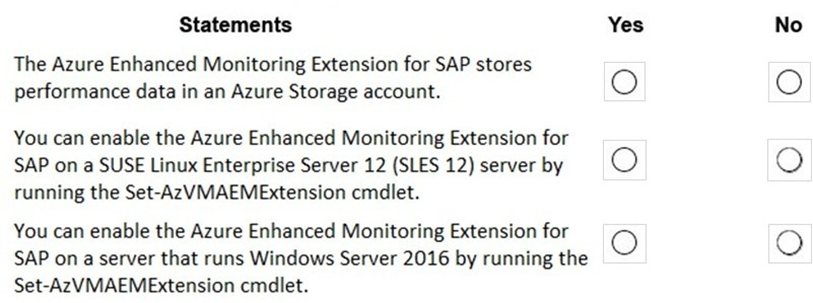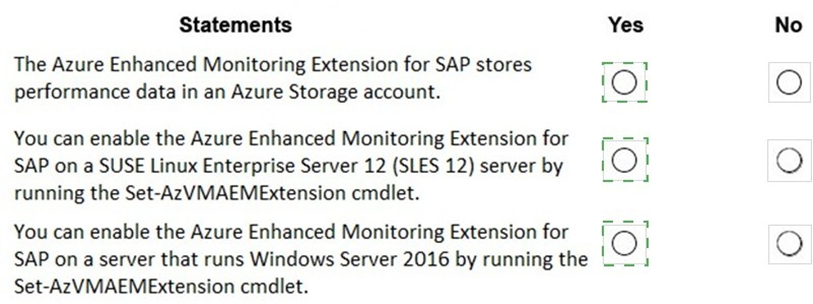Topic 2: Misc. Questions
Note: This question is part of a series of questions that present the same scenario. Each question in the series contains a unique solution that might meet the stated goals. Some question sets might have more than one correct solution, while others might not have a correct solution. After you answer a question in this section, you will NOT be able to return to it. As a result, these questions will not appear in the review screen. You have a complex SAP environment that has both ABAP- and Java-based systems. The current on-premises landscapes are based on SAP NetWeaver 7.0 (Unicode and Non- Unicode) running on Windows Server and Microsoft SQL Server.
You need to migrate the SAP environment to a HANA-certified Azure environment.
Solution: You deploy a new environment to Azure that uses SAP NetWeaver 7.4. You export the databases from the on-premises environment, and then you import the databases into the Azure environment. Does this meet the goal?
A.
Yes
B.
No
No
Explanation:
Instead use Azure Site Recovery to migrate.
You have an SAP production landscape on-premises and an SAP development landscape on Azure. You deploy a network virtual appliance to act as a firewall between the Azure subnet and the on-premises network. Solution: You configure route filters for Microsoft peering. Does this meet the goal?
A.
Yes
B.
No
Yes
You plan to deploy a scale-out SAP HANA deployment on Azure virtual machines that will contain a standby node.
You need to recommend a storage solution for the deployment.
What should you recommend? To answer, select the appropriate options in the answer area.
NOTE: Each correct selection is worth one point

Answer:

Explanation:

You have an on-premises SAP AnyDB deployment hosted on an operating system that is NOT supported in Azure. You need to migrate the deployment to Azure by performing a replatform and migration to SAP HANA. The solution must meet the following requirements:
• Minimize administrative effort.
• Minimize downtime.
What should you use?
A.
SAP Software Provisioning Manager
B.
SAP Software Update Manager
C.
Azure Migrate
D.
Azure Database Migration Service
SAP Software Update Manager
You have an SAP landscape on Azure that uses SAP HANA You perform a daily backup of HANA to Azure Blob Storage and retain copies of each backup for one year You need to reduce the backup storage costs. What should you implement?
A.
a stored access policy
B.
a Recovery Services Vault backup policy
C.
a storage access tier
a storage access tier
You deploy an SAP environment on Azure by following the SAP workload on Azure planning and deployment checklist.
You need to verify whether Azure Diagnostics is enabled. Which cmdlet should you run?
A.
Get-AzureVMAvailableExtension
B.
Get-AzVmDiagnosticsExtension
C.
Test-AzDeployment
D.
Test-VMConfigForSAP
Get-AzVmDiagnosticsExtension
Explanation:
The Get-AzVMDiagnosticsExtension cmdlet gets the settings of the Azure Diagnostics extension on a virtual machine.
For each of the following statements, select Yes if the statement is true. Otherwise, select No. NOTE Each correct selection is worth one point.

Answer:

Explanation:

For each of the following statements, select Yes if the statement is true. Otherwise, select No. NOTE: Each correct selection is worth one point.

Answer:

Explanation:

You plan to migrate an SAP HANA instance to Azure. You need to gather CPU metrics from the last 24 hours from the instance. Solution: You run SAP HANA Quick Sizer.Does this meet the goal?
A.
Yes
B.
No
No
Explanation:
The SAP HANA cockpit provides a single point of access to a range of SAP HANA administration and monitoring tasks. It is used to monitor and ensure the overall health of the system.
The HANA Monitoring dashboard also visualizes key HANA Metrics of SAP HANA system.
You have an Azure subscription. Your company has an SAP environment that runs on SUSE Linux Enterprise Server (SLES) servers and SAP HANA. The environment has a primary site and a disaster recovery site. Disaster recovery is based on SAP HANA system replication. The SAP ERP environment is 4 TB and has a projected growth of 5% per month.
The company has an uptime Service Level Agreement (SLA) of 99.99%, a maximum recovery time objective (RTO) of four hours, and a recovery point objective (RPO) of 10 minutes. You plan to migrate to Azure. You need to design an SAP landscape for the company. Which options meet the company’s requirements?
A.
Azure virtual machines and SLES for SAP application servers SAP HANA on Azure (Large Instances) that uses SAP HANA system replication for high availability and disaster recovery
B.
ASCS/ERS and SLES clustering that uses the Pacemaker fence agent SAP application servers deployed to an Azure Availability Zone SAP HANA on Azure (Large Instances) that uses SAP HANA system replication for database high
availability and disaster recovery
C.
SAP application instances deployed to an Azure Availability Set SAP HANA on Azure (Large Instances) that uses SAP HANA system replication for database high availability and disaster recovery
D.
ASCS/ERS and SLES clustering that uses the Azure fence agent SAP application servers deployed to an Azure Availability Set SAP HANA on Azure (Large Instances) that uses SAP HANA system replication for database high
availability and disaster recovery
ASCS/ERS and SLES clustering that uses the Pacemaker fence agent SAP application servers deployed to an Azure Availability Zone SAP HANA on Azure (Large Instances) that uses SAP HANA system replication for database high
availability and disaster recovery
Explanation:
With Availability Zones, Azure offers industry best 99.99% VM uptime SLA.
| Page 5 out of 22 Pages |
| Previous |